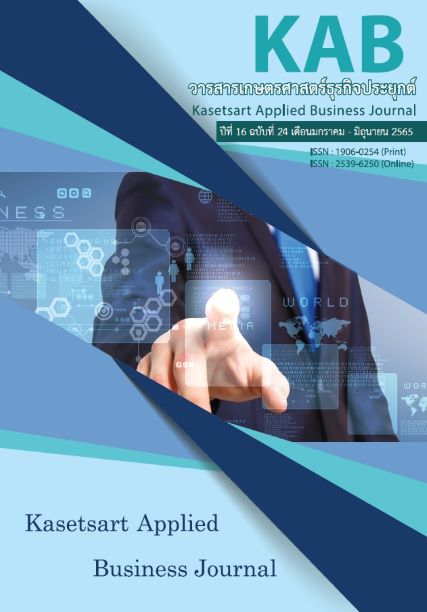ทุนทางสังคมและบุคลิกภาพของแบรนด์ที่ส่งผลต่อความตั้งใจซื้อสินค้าออนไลน์ ผ่านแพลตฟอร์มโซเชียลคอมเมิร์ซของผู้บริโภคกลุ่ม LGBTQ+
Main Article Content
บทคัดย่อ
การวิจัยครั้งนี้มีวัตถุประสงค์ เพื่อศึกษาว่า 1) ทุนทางสังคมมีผลปฏิสัมพันธ์ทางบวกต่อความสัมพันธ์ระหว่างบุคลิกภาพของแบรนด์และความตั้งใจซื้อ และ 2) ทุนทางสังคมมีอิทธิพลส่งผ่านบุคลิกภาพของแบรนด์ให้เกิดความตั้งใจซื้อ โดยใช้แบบสอบถามเป็นเครื่องมือและเก็บรวบรวมข้อมูลจากกลุ่ม LGBTQ+ จำนวน 424 ตัวอย่าง ผลการศึกษาพบว่า บุคลิกภาพของแบรนด์ และทุนทางสังคมส่งผลกระทบเชิงบวกต่อความตั้งใจซื้อสินค้าผ่านโซเชียลคอมเมิร์ซของกลุ่ม LGBTQ+ โดยทุนทางสังคมนั้นมีอิทธิพลส่งผ่านแบบสมบูรณ์ระหว่างความสัมพันธ์ของบุคลิกภาพของแบรนด์และความตั้งใจซื้อ ดังนั้น ผลการวิจัยในครั้งนี้ จึงเป็นส่วนหนึ่งของการสร้างคุณค่าในภาพลักษณ์ของกลุ่ม LGBTQ+ ในประเทศไทย ซึ่งยังคงเป็นประเด็นที่ควรให้การสนับสนุน และใช้เป็นข้อสนเทศในการศึกษาพฤติกรรมการบริโภคของกลุ่มผู้บริโภคที่แบ่งด้วยอัตลักษณ์ทางเพศ รวมถึงใช้เป็นแนวทางในการศึกษาวิจัยทางการตลาดที่อาจก่อให้เกิดบรรทัดฐานใหม่ เพื่อสนับสนุนการสร้างคุณค่าและทางเลือกใหม่ ๆ ของอัตลักษณ์ทางเพศต่อไปในอนาคต
Article Details

อนุญาตภายใต้เงื่อนไข Creative Commons Attribution-NonCommercial-NoDerivatives 4.0 International License.
Journal of TCI is licensed under a Creative Commons Attribution-NonCommercial-NoDerivatives 4.0 International (CC BY-NC-ND 4.0) licence, unless otherwise stated. Please read our Policies page for more information...
เอกสารอ้างอิง
ชเนตตี ทินนาม, โกสุม โอมพรนุวัฒน์ และ รัตนา ด้วยดี. (2563). ยุทธศาสตร์สุขภาวะ LGBTIQN+ พ.ศ. 2564-2566. สมาคมเพศวิถีศึกษา. 28-30.
ณัฐพงศ์ เล็กเลิศสุนทร, พิทวัส เอื้อสังคมเศรษฐ์ และยุรพร ศุทธรัตน์. (2562). อิทธิพลของทุนทางสังคมภายในและภายนอกที่มีต่อผลการดำเนินงานของธุรกิจครอบครัวที่ประกอบกิจกรรมเพื่อสังคม. วารสารเกษตรศาสตร์ธุรกิจประยุกต์, 13(18). 53-68.
Aaker, D. A. (1996). Measuring brand equity across products and markets. California Management review, 38(3).
Aaker, J. L. (1997). Dimensions of brand personality. Journal of marketing research, 347-356.
Aiken, L. S., & West, S. G. (1991). Testing and interpreting interactions in multiple regression. Newbury Park, CA: Sage.
Baron, R. M., & Kenny, D. A. (1986). The moderator-mediator variable distinction in social psychological research: Conceptual, strategic and statistical considerations. Journal of Personality and Social Psychology, 51(6), 1173-1182.
Barron, J. (2019). The Visual MBA. Publisher: Penguin UK, Format: Paper Back, Pages: 208
Bourdieu, P. (1997). Economic Capital, Cultural Capital, and Social Capital. The Hidden Mechanisms of Power. VSA-Verlag, Hamburg, 49-79.
Chen, J., & Shen, X. (2015). Consumers’ decisions in s-commerce context: An empirical investigation. Decision Support Systems, 79, 55–64.
Chiu, C.-M., Hsu, M. H., & Wang, E. T. G. (2006). Understanding knowledge sharing in virtual communities: an integration of social capital and social cognitive theories. Decis. Support Syst. 42(3), 1872–1888.
Chu, S. C., & Sung, Y. (2011). Brand personality dimensions in China. Journal of marketing communications, 17(3), 163-181.
Cooke, P. (2007). Social capital, embeddedness, and market interactions: An analysis of firm performance in UK regions. Review of Social Economy, 65(1), 79–106.
Das, G. (2014). Linkages of retailer personality, perceived quality and purchase intention with retailer loyalty: A study of Indian non-food retailing. Journal of Retailing and Consumer Services, 21(3), 407-414.
Dentsu INC. (2019). Dentsu LGBT Survey 2018 Overview. Retrieved from. http://www.dentsu.com.
Dirgantari, P. D., Sholehah, S., & Widjajanta, B. (2021). Increasing Purchase Intention Through Brand Personality. Proceedings of the 5th Global Conference on Business, Management and Entrepreneurship (GCBME 2020), 187(Gcbme 2020), 411–416.
Electronic Transactions Development Agency. (2019). Thailand Internet User Behavior 2019. Retrieved from https://www.etda.or.th/th/Useful-Resource/publications/Thailand-Internet-User-Behavior2019_EN.
Emhan, A., Tongur, A., & Turkoglu, I. (2016). An Analysis of The Social Capital, Organizational Commitment and Performance in The Public Sector of Southeastern Turkey. Transylvanian Review of Administrative Sciences, 46, 49-62.
Ghahtarani, A., Sheikhmohammady, M., & Rostami, M. (2020). The impact of social capital and social interaction on customers’ purchase intention, considering knowledge sharing in social commerce context. Journal of Innovation and Knowledge, 5(3), 191–199.
Graeff, T. R. (1997). Consumption Situations and the Effects of Brand Image on Consumers Brand Evaluation. Psychology and Marketing, 14, 49-70.
Hair, J. F. J., Bush, R. P., & Ortinau, D. J. (2006). Marketing research: Within a changing information environment (3rd ed.). New Delhi: McGraw-Hill.
Huysman, M., & Wulf, V. (Eds.). (2004). Social capital and information technology. Mit Press.
Kim, J., Kang, S., & Lee, K. H. (2020). How social capital impacts the purchase intention of sustainable fashion products. Journal of Business Research, 117(November 2017), 596–603.
Kim, S., & Park, H. (2013). Effects of various characteristics of social commerce (s-commerce) on consumers’ trust and trust performance. International Journal of Information Management, 33(2), 318–332.
Kittitteerasack, P., Sangngam, J. & Matthews, A. K. (2017). The fundamentals of child and adolescent nursing in improving mental and psychosocial health among gender variant children in Thailand. Journal of Nursing Science. 36(1), 4-16.
Mowen, J. C., & Minor, M. (1998). Consumer behavior (5th ed.). Upper Saddle River, New Jersey: Pearson Hall.
Rutter, R., Chalvatzis, K. J., Roper, S., & Lettice, F. (2018). Branding instead of product innovation: A study on the brand personalities of the UK’s electricity market. European management review, 15(2), 255-272.
Saha, M. & Banerjee, S. (2015). Impact of Social Capital on Small Firm Performance in West Bengal. Journal of Entrepreneurship, 24(2), 91-114.
Schiffman, L. G., & Kanuk, L. L. (2004). Consumer behavior (8th ed.). Upper saddleriver. New Jersey: Prentice Hall.
Schlosser, A. E. (2003). Experiencing products in the virtual world: The role of goal and imagery in influencing attitudes versus purchase intent. Journal of Consumer Research, 30(2), 184-198.
Sirgy, M. J. (1982). Self-Concept in Consumer Behavior: A Critical Review. Journal of Consumer Research, 9, 287-300.
Stern, B. L., Bush, R. F., & Hair, J. F. Jr. (1977). The Self-Image/Store Image Matching Process: An Empirical Test. Journal of Business, 20, 63-69.
Tate, C. (2014). Gender identity as a personality process. Gender identity: disorders, developmental perspectives and social implications. Hauppauge, NY: Nova Science Publishers.
Tsabitah, N., & Anggraeni, R. (2021). The Effect of Brand Image, Brand Personality and Brand Awareness on Purchase Intention of Local Fashion Brand “This Is April” Management Department , Faculty of Economics and Business , Universitas Brawijaya. 25(2).
Vahdati, H., & Nejad, S. H. M. (2016). Brand personality toward customer purchase intention: The intermediate role of electronic word-of-mouth and brand equity. Asian Academy of Management Journal, 21(2), 1–26.
Wang, Y., & Yu, C. (2017). Social interaction-based consumer decision-making model in social commerce: The role of word of mouth and observational learning. International Journal of Information Management, 37(3), 179–189.
Yadegarfard, M., Meinhold-Bergmann, M. E., & Ho, R. (2014). Family rejection, social isolation, and Loneliness as predictors of negative health outcomes (depression, suicidal ideate on, and sexual risk behavior) among Thai male-to-female transgender adolescents. Journal of LGBT Youth, 11(4), 347-363.
Yamane, T. (1973). Statistics: An Introductory Analysis (3rded.). New York: Harper and Row Publications.
Yang, X. (2021). Understanding consumers’ purchase intentions in social commerce through social capital: Evidence from sem and fsqca. Journal of Theoretical and Applied Electronic Commerce Research, 16(5), 1557–1570.


